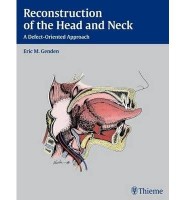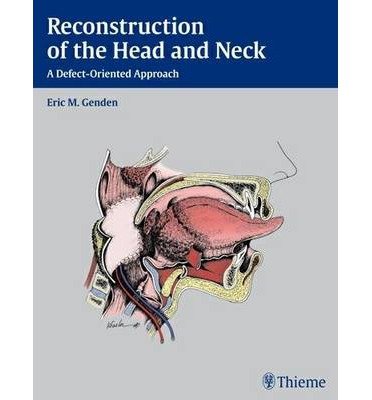 Editor: Eric M. Genden, MD. Medical Illustrator: Scott M. Kessler, MD.
Editor: Eric M. Genden, MD. Medical Illustrator: Scott M. Kessler, MD.
Publisher: Thieme – 180 pages
Book Review by: Nano Khilnani
It is not clear when head and neck reconstructive surgery actually began, Dr. Richard E. Hayden, who wrote the Foreword to this book, points out. He is chairman and professor at the department of otolaryngology – head and neck surgery at Mayo Clinic in Arizona.
The earliest instance he mentions of a procedure in this field was in 1959 when Seidenberg “reconstructed a total laryngopharyngectomy defect with a vascularized jejunal segment.” Other procedures were performed in 1963 and 1965, respectively by McGregor and Bakamjian with the “introduction of the first reliable axial pattern skin flaps from the forehead and shoulder.
He writes that these flaps were extensively used by head and surgeons in the 1960s and 1970s for a wide variety of defects. But unfortunately they failed to duplicate the missing tissue, he points out. There were various other operations later. We cite them below using Hayden’s own words:
- 1972: Buncke’s miscrovascular transfer of omentum to cover large full thickness defects
- 1973: Taylor and Daniels’ transfer of a miscrovascular free cutaneous groin flap to the sacral area
- 1975: Panje, et al used a free groin flap for tongue reconstruction, being the first application of a free cutaneous flap to the head and neck.
- 1978: Taylor demonstrated: the original free cutaneous flap–the groin flap–was incapable of successfully carrying the iliac bone on its superficial circumflex iliac arterial pedicle.
- 1979: introduction of the pedicled pectoralis major flap, which did little to swell the ranks of free flap surgery advocates.
- 1980s: a flood of new flaps were introduced
- 1990s: Free tissue transfer offered the closest match of donor tissues with those missing in the head and neck defect.
- 2000: complex microvascular free tissue transfer being employed to reconstruct small defects that could have been equally or in some cases even better repaired with simple local or regional flaps or even, in rare cases, healing by secondary intention.
The scope of coverage of this book can be gleaned from its Contents we show you below:
- Oral Cavity Reconstruction
- Oromandibular Complex Reconstruction
- Palatomaxillary Complex Reconstruction
- Cheek and Neck Reconstruction
- Pharynx, Cervical Esophagus, and Hypopharynx Reconstruction
- Skull Base Reconstruction
- Scalp Reconstruction
- Management of the Paralyzed Face
- Pediatric Head and Neck Reconstruction
- Microvascular Reconstruction of the Head and Neck
This book has been written for use by you, the practicing and aspiring head and neck surgeons. Among the benefits you will derive from this book are the following:
- Organized by specific defect, so you can easily find the reconstructive options for your patients, the 10 chapters have been written by 15 authors from the Mount Sinai School of Medicine in New York, New York, and other U.S. cities.
- Experts cover the reconstruction of major soft tissue and bony and muscular defects of the head, neck, and skull base in detail.
- 200+ color illustrations, along with over 100 line drawings by Scott M. Kessler, MD help clarify the surgical methods described in the text.
- Experienced surgeons review approaches to reconstruction and the fine points that surgeons need to know for the best outcomes.
- For each defect, the steps in the procedure, the orientation of the flap, and the details that confer excellent surgical results are covered.
This is an excellent, authoritative, and well-illustrated volume on reconstruction of the head and neck.
Editor:
Eric M. Genden, MD, FACS is with the Department of Otolaryngology – Head and Neck Surgery at Mount Sinai School of Medicine in New York, New York. He is a graduate of Columbia University and Mount Sinai School of Medicine, where he completed his degree with a distinction in Research.
He then completed his residency training in otolaryngology – head and neck surgery at Washington University, Barnes Hospital in St. Louis, Missouri, and then completed fellowship training in head and neck oncology and microvascular surgery at Mount Sinai Medical Center in New York, New York.
Illustrator:
Scott M. Kessler, MD is a Board-certified otolaryngologist in private solo practice in New York, New York. He has been on the attending staff of Mount Sinai Hospital in New York for the past 28 years.
He earned his medical degree at the Mount Sinai School of Medicine, and following a surgical internship at Barnes Hospital in St. Louis, Missouri, he completed his residency in Mount Sinai Hospital in New York.
Contributors:
Douglas B. Chepeha, MD, MPH; John R. de Almeida, MD; R. Kelly Gallagher, MD; Eric M. Genden, MD, FACS; Vivek V. Gurudutt, MD; Andrew Kleinberger, MD; William Lawson, MD; Brett A. Miles, MD; Vijay Mukhija, MD; Matthew Old, MD, FACS; Andrew Sikora, MD; Theodoros N. Teknos, MD; Marita Teng, MD; Mark K. Wax, MD, FACS;and Stephen M. Weber, MD, PhD.







